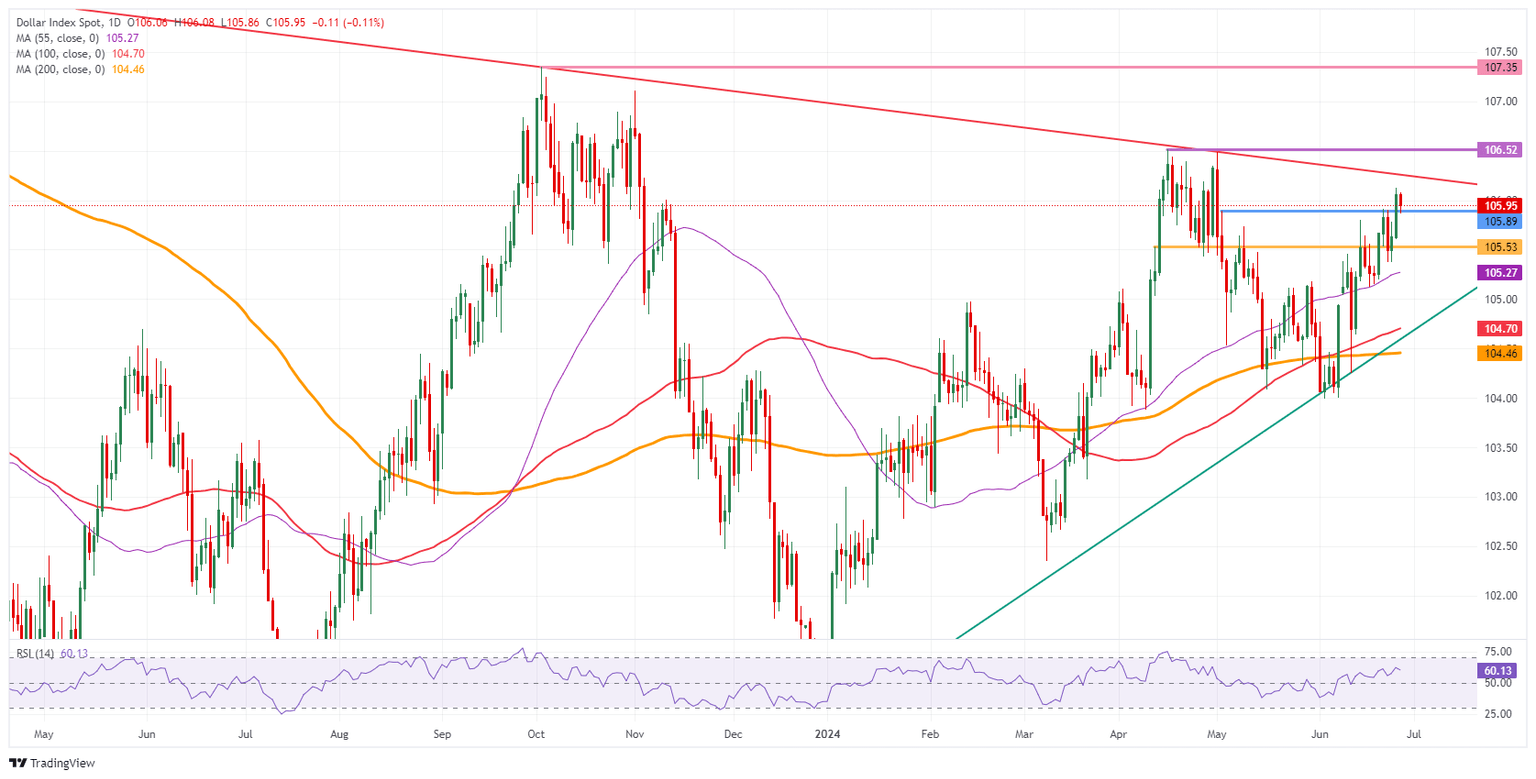US Dollar eases after Durable Goods orders come to a halt
- The US Dollar trades in deep red against nearly all major peers.
- The data dumpt with US GDP, Durable Goods, and weekly Jobless Claims did not go down well with markets.
- The US Dollar index says goodbey to 106.00 and heads lower.

The US Dollar (USD) falls and in the process is erasing all gains from past Wednesday. The big batch of data points that came out made traders cherry pick which elements they would take for their assessment on where to position the US Dollar. Elements such as the uptick in Continuing Claims, the soaring Wholesales Inventory number and the flat fall of Durable Goods was enough to send the US Dollar lower.
On the US economic calendar front, all data is out of the way and markets will now be on the lookout for the Federal Reserve's preferred inflation Gauge: the Personal Consumption Expenditures on Friday. Should those fade as well, as a sign of further disinflation, markets might challenge the current hawkish stance of the Fed with a weaker US Dollar at hand. That would mean in the US Dollar Index, that a fall back to 105.00 or lower could be in the cards.
Daily digest market movers: Consumer signals end of the line
- At 12:30 GMT, nearly all important data points were released for this Thursday:
- US Gross Domestic Product for the third quarter:
- Headline GDP grew at an annualized rate of 1.4%, more than the 1.3% previously estimated.
- GDP Price Index remained stable at 3.1%.
- The Headline Personal Consumption Expenditure Price index went from 3.3% to 3.4%, while the core reading also ticked higher from 3.6% to 3.7%.
- US Durable Goods for May:
- Headline Durable Goods orders fell flat to 0.1%, from a revised 0.6% to only 0.2%.
- Durable Goods without Cars and Transportation missed estimates and fell lower from 0.4% to -0.1%.
- Weekly Jobless Claims for the week ending June 14th:
- Initial Jobless Claims came in stronger, from 238,000 to 233,000..
- Continuing Claims were an issue, as they jumped from 1,821,000 to 1,839,000.
- Pending Home Sales for May declined for a second week in a row, this time by 2.1%, signaling more issues at hand for the US housing market.
- US Gross Domestic Product for the third quarter:
- At 15:00 GMT, the Kansas Fed Manufacturing Activity Index for June will be released. The previous print was at -1.
- Equities are trying to snap the negativeness for this week with US equities soaring after the US data numbers with the idea the Fed's hawkish stance is a touch overdone.
- The CME Fedwatch Tool is broadly backing a rate cut in September despite recent comments from Fed officials. The odds now stand at 56.3% for a 25-basis-point cut. A rate pause stands at a 37.7% chance, while a 50-basis-point rate cut has a slim 6.0% possibility.
- The US 10-year benchmark rate trades near the weekly high at 4.28%.
US Dollar Index Technical Analysis: PCE to unlock more weakness?
The US Dollar Index (DXY) has been strolling through markets with a big thanks to some outside effects. Although for now the near support level at 105.89 looks to be holding, expect with the mixture of data this Thursday and Friday to cause some whipsaw moves. Rather look for the dust to settle late Friday to see where the US Dollar will be heading once a clear picture has been revealed.
On the upside, the biggest challenge remains 106.52, the year-to-date high from April 16. A rally to 107.35, a level not seen since October 2023, would need to be driven by a surprise uptick in US inflation or a further hawkish shift from the Fed.
On the downside, 105.53 is the first support ahead of a trifecta of Simple Moving Averages (SMA). First is the 55-day SMA at 105.27, safeguarding the 105.00 round figure. A touch lower, near 104.70 and 104.46, both the 100-day and the 200-day SMA form a double layer of protection to support any declines. Should this area be broken, look for 104.00 to salvage the situation.
US Dollar Index: Daily Chart
Interest rates FAQs
Interest rates are charged by financial institutions on loans to borrowers and are paid as interest to savers and depositors. They are influenced by base lending rates, which are set by central banks in response to changes in the economy. Central banks normally have a mandate to ensure price stability, which in most cases means targeting a core inflation rate of around 2%. If inflation falls below target the central bank may cut base lending rates, with a view to stimulating lending and boosting the economy. If inflation rises substantially above 2% it normally results in the central bank raising base lending rates in an attempt to lower inflation.
Higher interest rates generally help strengthen a country’s currency as they make it a more attractive place for global investors to park their money.
Higher interest rates overall weigh on the price of Gold because they increase the opportunity cost of holding Gold instead of investing in an interest-bearing asset or placing cash in the bank. If interest rates are high that usually pushes up the price of the US Dollar (USD), and since Gold is priced in Dollars, this has the effect of lowering the price of Gold.
The Fed funds rate is the overnight rate at which US banks lend to each other. It is the oft-quoted headline rate set by the Federal Reserve at its FOMC meetings. It is set as a range, for example 4.75%-5.00%, though the upper limit (in that case 5.00%) is the quoted figure. Market expectations for future Fed funds rate are tracked by the CME FedWatch tool, which shapes how many financial markets behave in anticipation of future Federal Reserve monetary policy decisions.
Author

Filip Lagaart
FXStreet
Filip Lagaart is a former sales/trader with over 15 years of financial markets expertise under its belt.


















